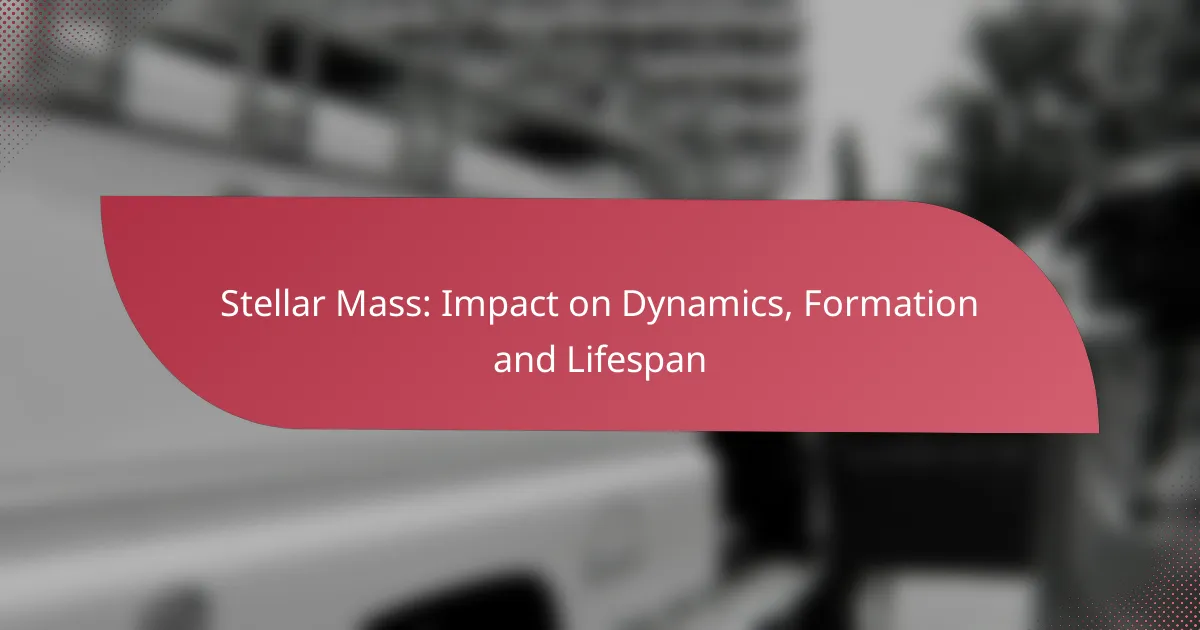Stellar mass plays a pivotal role in shaping the dynamics, formation, and lifespan of stars. It dictates the rate of star formation and influences the gravitational interactions within star clusters, affecting the movement of celestial bodies. Additionally, higher mass stars consume their nuclear fuel rapidly, leading to shorter lifespans and distinct evolutionary paths compared to their lower mass counterparts.

How does stellar mass affect star formation?
Stellar mass significantly influences the rate of star formation, the dynamics of surrounding gas, and the processes of nuclear fusion within stars. Higher mass stars form more quickly and have a profound impact on their environment, shaping the conditions for future star formation.
Higher mass leads to faster formation rates
Higher mass stars typically form at a faster rate compared to their lower mass counterparts. This is due to their ability to accumulate mass more quickly from surrounding gas and dust, often leading to formation timescales of a few hundred thousand years. In contrast, lower mass stars can take millions of years to form.
The rapid formation of massive stars can trigger feedback mechanisms that influence nearby star formation. For instance, the intense radiation and stellar winds from these stars can compress nearby gas clouds, potentially leading to the birth of additional stars in a relatively short time frame.
Massive stars influence surrounding gas dynamics
Massive stars have a strong gravitational pull and emit significant energy, which affects the dynamics of the gas in their vicinity. Their radiation pressure can push away surrounding gas, while their supernova explosions can create shock waves that compress nearby molecular clouds, fostering new star formation.
This interaction between massive stars and their environment can lead to complex gas dynamics, including the formation of stellar clusters. The presence of massive stars often dictates the structure and evolution of star-forming regions, making them pivotal in galactic ecology.
Stellar mass determines fusion processes
The mass of a star directly influences the fusion processes that occur in its core. Massive stars primarily fuse hydrogen into helium at a much faster rate, and as they evolve, they can fuse heavier elements, leading to the creation of elements like carbon, oxygen, and iron. This process occurs over shorter timescales compared to lower mass stars, which may spend longer periods in hydrogen burning.
This difference in fusion processes not only affects the lifespan of the stars but also the types of supernovae they produce. Massive stars typically end their lives in spectacular supernova explosions, enriching the interstellar medium with heavy elements, while lower mass stars may end as white dwarfs after a more subdued evolution.

What is the impact of stellar mass on stellar dynamics?
The mass of a star significantly influences its dynamics, including gravitational interactions, orbital periods, and the stability of star clusters. Higher mass stars tend to have stronger gravitational pulls, which affects their movement and the behavior of surrounding celestial bodies.
Mass influences gravitational interactions
The gravitational force between stars is directly proportional to their masses. This means that more massive stars exert a stronger gravitational pull on nearby objects, affecting their trajectories and interactions. For example, in a binary star system, the more massive star will dominate the orbital dynamics, leading to complex interactions that can result in mass transfer between the stars.
In star clusters, the gravitational influence of massive stars can lead to the formation of hierarchical structures, where smaller stars are drawn towards larger ones. This can result in dynamic phenomena such as the ejection of lower-mass stars from the cluster, altering the overall mass distribution and stability of the group.
Higher mass stars have shorter orbital periods
Higher mass stars typically have shorter orbital periods due to their stronger gravitational fields. For instance, in binary systems, a massive star can complete an orbit in just a few days, while less massive stars may take weeks or months. This rapid movement can lead to significant changes in the system’s dynamics over relatively short timescales.
Additionally, the influence of mass on orbital periods can affect the timing of events such as supernova explosions. A massive star may exhaust its nuclear fuel and explode much sooner than a lower mass star, impacting the surrounding environment and potentially triggering the formation of new stars.
Mass affects stability and evolution of star clusters
The mass distribution within a star cluster plays a crucial role in its stability and evolution. Clusters with a higher proportion of massive stars tend to be less stable, as these stars can quickly evolve and end their life cycles, leading to rapid changes in the cluster’s structure. In contrast, clusters dominated by lower mass stars can remain stable for much longer periods.
As massive stars evolve, they can influence the dynamics of the cluster by creating shock waves and stellar winds, which can trigger star formation in nearby gas clouds. This interaction highlights the importance of mass in determining not only the fate of individual stars but also the overall evolution of star clusters.

How does stellar mass determine lifespan?
Stellar mass is a crucial factor in determining a star’s lifespan, with more massive stars burning through their nuclear fuel at a much faster rate than their lower mass counterparts. As a result, the lifespan of a star can vary significantly based on its mass, influencing its evolution and ultimate fate.
Massive stars have shorter lifespans
Massive stars, typically those with more than eight times the mass of the Sun, have significantly shorter lifespans, often ranging from a few million to a few tens of millions of years. Their high mass leads to intense gravitational pressure, resulting in rapid fusion rates that exhaust their hydrogen fuel quickly. For example, a star like Betelgeuse, which is about 20 times the mass of the Sun, may only live for around 10 million years before undergoing a supernova.
Lower mass stars can live for billions of years
In contrast, lower mass stars, such as red dwarfs, can have lifespans extending from tens of billions to even trillions of years. These stars burn their fuel slowly, allowing them to maintain stable fusion for an extended period. For instance, a star with half the mass of the Sun can live for over 50 billion years, far exceeding the current age of the universe.
Mass impacts the end-of-life stages of stars
The mass of a star also determines its end-of-life stages, influencing whether it will become a white dwarf, neutron star, or black hole. Massive stars typically end their lives in spectacular supernova explosions, leaving behind neutron stars or black holes, while lower mass stars shed their outer layers and evolve into white dwarfs. This difference in fate is a direct consequence of the varying nuclear processes and gravitational forces at play during their lifetimes.

What are the criteria for classifying stars by mass?
Stars are classified by mass primarily based on their initial mass, which influences their formation, evolution, and eventual fate. This classification helps astronomers understand the dynamics of stellar populations and the processes that govern star life cycles.
Mass ranges for different stellar types
Stars can be categorized into several types based on their mass ranges. Generally, low-mass stars, such as red dwarfs, have masses less than about 0.8 solar masses, while intermediate-mass stars range from approximately 0.8 to 8 solar masses. High-mass stars exceed 8 solar masses and can go up to over 100 solar masses.
The mass of a star significantly affects its temperature, luminosity, and lifespan. For example, low-mass stars can burn for tens of billions of years, while high-mass stars may only last a few million years before ending in supernova explosions.
Classification systems like Hertzsprung-Russell diagram
The Hertzsprung-Russell (H-R) diagram is a key tool for classifying stars based on their luminosity and temperature, which are closely related to their mass. In this diagram, stars are plotted with temperature on the horizontal axis and luminosity on the vertical axis, revealing distinct groups such as main sequence stars, giants, and white dwarfs.
This classification system allows astronomers to infer a star’s mass and evolutionary stage. For instance, main sequence stars, where most stars reside, show a clear relationship between mass and brightness, with more massive stars being hotter and more luminous.

How does stellar mass influence supernova events?
Stellar mass significantly impacts the occurrence and type of supernova events. Higher mass stars tend to undergo more dramatic core collapse processes, leading to explosive outcomes that vary based on their initial mass and composition.
Massive stars undergo core collapse
Massive stars, typically those with masses greater than eight solar masses, end their lives through a core collapse mechanism. As these stars exhaust their nuclear fuel, their cores become unstable and collapse under gravity, leading to extreme temperatures and pressures.
This collapse triggers a rebound effect, resulting in an explosive release of energy. The outer layers of the star are expelled into space, contributing to the formation of new stars and planetary systems from the ejected material.
Type II supernovae linked to high mass stars
Type II supernovae are specifically associated with high mass stars that experience core collapse. These events are characterized by a rapid increase in brightness, often outshining entire galaxies for a short period.
Typically, Type II supernovae occur in stars with initial masses ranging from about eight to over fifty solar masses. The remnants of these explosions can form neutron stars or black holes, depending on the remaining mass after the supernova event.

What are the emerging trends in stellar mass research?
Emerging trends in stellar mass research focus on enhanced observational techniques and innovative theoretical models that deepen our understanding of stellar dynamics, formation, and lifespan. These advancements are reshaping how astronomers study the relationship between stellar mass and various astrophysical phenomena.
Advances in observational technology
Recent improvements in observational technology, such as high-resolution imaging and spectroscopy, have significantly enhanced our ability to measure stellar masses accurately. Instruments like the James Webb Space Telescope and ground-based observatories equipped with adaptive optics allow astronomers to observe distant stars and their properties with unprecedented clarity.
These technologies enable the detection of faint stars and the analysis of their light spectra, which provides insights into their mass, temperature, and composition. As a result, researchers can better understand the distribution of stellar masses in different environments, such as star clusters and galaxies.
New models of stellar evolution
Innovative models of stellar evolution are being developed to explain how stars of varying masses form, evolve, and ultimately end their life cycles. These models incorporate complex physics, including nuclear fusion processes and mass loss mechanisms, to simulate the life stages of stars more accurately.
For instance, recent simulations suggest that massive stars undergo rapid changes during their lifetimes, influencing their final outcomes, such as supernova explosions or the formation of black holes. Understanding these processes helps astronomers predict the impact of stellar mass on the chemical enrichment of galaxies.
Impact of stellar mass on galaxy formation
The mass of stars plays a crucial role in the formation and evolution of galaxies. Heavier stars tend to form in denser regions of gas and dust, influencing the overall structure and dynamics of their host galaxies. This relationship is essential for understanding galaxy morphology and the distribution of different stellar populations.
Moreover, the feedback from massive stars, through processes like supernovae and stellar winds, can regulate star formation rates and affect the interstellar medium. This interplay highlights the importance of stellar mass in shaping galaxies over cosmic time, providing insights into the evolution of the universe.



